Udaipur: A royal family spat dripped on to the streets of Udaipur three days ago and turned the city of lakes into a mini-minefield. To defuse the tension, Udaipur worked in synchrony, making way for a gleaming red SUV to glide from one palace to the next — for a deity-darshan. No barrier was breached, and no rule was flouted, particularly due to hundreds of sombre-faced cops in riot gear. Inside the SUV was a safa, a sword, and Vishvaraj Singh. The man who is both a BJP MLA and an anachronistic emblem.
He was allowed into the now notorious City Palace and declared as the new head of the Mewar royal family. With this, a 72 hour saga between two cousins, which had even the government on tenterhooks, came to an end.
Royal family battles are not new to India. When prime real estate meets lofty traditions, and when myth-making is a family past-time — a high-stakes clash of egos is inevitable. The woes of the erstwhile house of Mewar are not unique. The Bikaner family has followed suit, with cross FIRs being filed. It’s a tale, if not as old as time, as old as the families. The longwinding Jai Mahal Palace and Ram Bagh Palace ownership dispute came to an end after a 15-year-long court battle.
Amrit Kaur, daughter of Harinder Singh Brar, the last ruler of what was the princely state of Faridkot, challenged her father’s will. She fought a legal battle involving property worth $2.4 billion for three decades before the top court brought the curtains down in 2020. About a decade ago, the royal house of Mysore was witness to an $ 8 billion fracas, when a cousin threw his hat into the running — staking his claim to the family fortune. And perhaps the biggest and the bloodiest of royal family battles happened over two decades ago in neighbouring Nepal when nine members of the royal family were killed. A shift to a constitutional monarchy was believed to be the cause of the massacre.

Vishvaraj Singh’s act of worship Monday culminated in stone-pelting when he and his supporters were denied entry into the City Palace, under the jurisdiction of his uncle Arvind Singh. It was just the latest episode in a decades-long family saga. And it brought the city to its knees — streets were emptied out of tourists, shops had their shutters down, and there was a restlessness in the air. The Indian family dispute has a stock image — but in the case of the Mewars, the fight transcends court-dates and a measly plot of land. It percolates down to an entire city.
“It is my right. And that’s why I saw this kind of support. The affectionate bond between me and the people of Udaipur continues,” said Vishvaraj Singh, who is also a BJP MLA from Nathwara. He doesn’t fit Mewar’s masculine, warrior archetype — he’s softspoken to the point where one has to strain to hear him. “It would’ve been nice if it was done peacefully. But at least it’s done.”
At Vishvaraj Singh’s residence, Samor Bagh, less than a kilometre from the City Palace, spontaneous cries of “Maharana Pratap ki Jai” and “Jai Mewar” ricocheted through the grounds — as supporters of the family arrived at the estate to pay homage to thousand-year-old traditions that remain embedded, not just in the Mewars, but in the people of Udaipur.
They watched spellbound as Singh prayed and fed a decked up, increasingly restless horse — with golden hearts on her bridle.
“India is a democracy, but that doesn’t mean we can forget the traditions of Mewar,” said Sankar Shri Hajala, a BJP worker with a tilak that stretched from the beginning of his forehead to the tip of his nose. “Whether it’s kalyug or satyug, our traditions will carry on. If Hindustan abandons its traditions, then there’s nothing that separates us from other countries.”
This is not that many people. We expected thousands to come. But the Maharana (Vishvaraj Singh) is mellow, and very humble. He doesn’t want people to get into trouble because of him
— Arjun Singh Shekhawati, part of a family of erstwhile noblemen
According to Singh, they wouldn’t have arrived in droves on Monday. It would’ve business as usual if he had simply been allowed to enter. He wasn’t attempting to capture the City Palace, he simply wanted to pray to their family deity and validate his Maharana-ship.
But to his surprise, the palace was fortified. And ultimately, a clash ensued between the two parties — as fevered Rajputs joined their ‘family’.
Two days later, Vishvaraj Singh, the Maharana, entered the palace again. This time with a grand-total of four people, much to the chagrin of some of his supporters, who held on to his car — breaking into a run as it sped away.
The family drama, palace intrigue, thousands of acres of royal property and protestors on the street – but in the end, the coronation of the new Udaipur king was an underwhelming affair. His entry into the palace wasn’t grand and it lacked that over-the-topness Rajasthan royals are known for. A government-mediated truce and he just slunk in.
“This (crowd) is not that many people. We expected thousands to come. But the Maharana is mellow, and very humble. He doesn’t want people to get into trouble because of him,” said Arjun Singh Shekhawati, part of a family of erstwhile noblemen. He’s dressed in a mint-green safa, has signature Rajput studs in both ears, and a white bandhgala. “We’re all part of one big family.”
India is a democracy, but that doesn’t mean we can forget the traditions of Mewar — Sankar Shri Hajala, a BJP worker
Also read: ‘Want to buy peace’—Narendra Jain can’t get Salman Rushdie to end a 5-decade legal battle
Tourists get a royal taste
The street between City Palace and Samor Bagh, an otherwise chock-a-block stretch, was completely bereft of tourists on Wednesday morning. Policemen are gathered in groups of about fifty on both sides, some of them dressed in riot gear. Udaipur’s tourist vibe had been disrupted. A couple of bewildered looking tourists informed a cop that they needed to cross a barricade in order to locate an auto-rickshaw. They were allowed.
Dipesh Mali walked aimlessly through the street between City Palace and Samor Bagh, lamenting the curfew that had been imposed on him. He runs a food joint on what is Udaipur’s most tourist-heavy lane — but there was not a soul to be seen the same afternoon.
“Everything is ruined. All three of the restaurants in which I work are closed,” he said. “People come to Udaipur to see the City Palace. It looks like they’re preparing for some grand war of sorts.”
“The people’s sentiments are with the Maharana. But this has to stop. They have to run a business at the end of the day,” said Randhir Singh Bhinder, former MLA of Ballabgarh. If the princely states had continued, Bhinder would’ve been one of 23 umraos, a member of the Maharana’s council of ministers.
Back in the day, in order to rule, the Mahrana needed the approval of the umraos. They’re essential to the process.
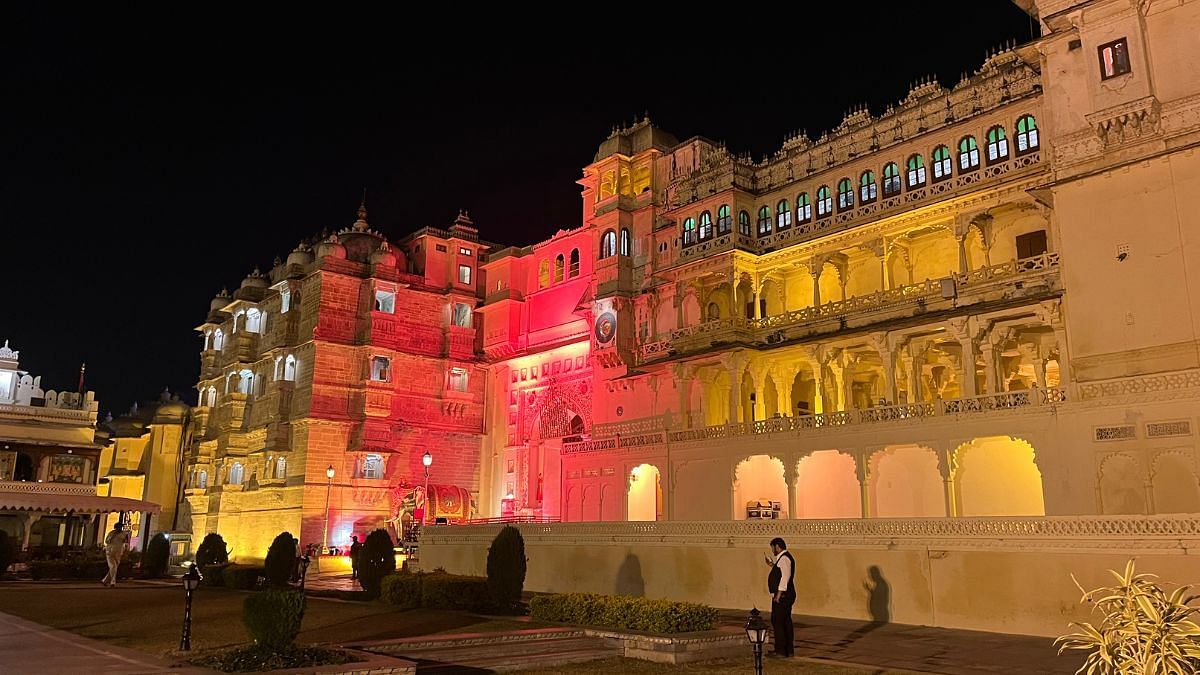
The City Palace is home to three hotels — Taj Lake Palace, Fateh Prakash and Shiv Nivas. All three are vital to securing Udaipur’s reputation as the wedding destination of dreams. The Arvind Singh faction of the Mewars oversees all three properties, and chose to shut down Fateh Prakash and Shiv Nivas after Monday night’s events.
“Shutting the place down was a necessity. We’re not going to compromise our safety, security, and least of all — our dignity,” said Lakshyaraj Singh, son of Arvind Singh. Arvind Singh, according to those close to the family, hasn’t been seen in public for the past three years, and has, for all practical purposes, passed the baton down to Lakshyaraj. “Our business is not bigger than our self-respect.”
There’s a dramatic wrought-iron gate, embellished with gold suns, that looks out into the Doodh Talai, a restored pond next to Udaipur’s Lake Pichola. It’s night-time and the water glitters. But the feud is omnipresent — as is evident from a fleet of security guards — all of whom have ‘Jai Mewar’ stitched onto the back of their uniforms.
Bewildered looking tourists stroll in from time to time. The gate opens for them, and they wheel their suitcases in. Members of the media sip cups of tea outside, only allowed when Lakshyaraj deigns to grant them permission. A shop selling tourist-trinkets has been abandoned — but the lights have been left on. The Udaipur museum, also inside the palace compound, is a ghost-town.
Shutting the place down was a necessity. We’re not going to compromise our safety, security, and least of all — our dignity
— Lakshyaraj Singh, Vishvaraj Singh’s cousin
“I’m trying to piece it together (the royal mess). So the king hates his cousin? It’s been pretty crazy,” said Sonia, visiting Udaipur from New York.
Her mother chimed in excitedly — “we saw the king and the pollution. What else do we need? Our holiday’s complete.” It’s Wednesday night, as they waited for their autorickshaw, supposedly secure behind a police barricade — Vishvaraj’s red SUV made its entry.
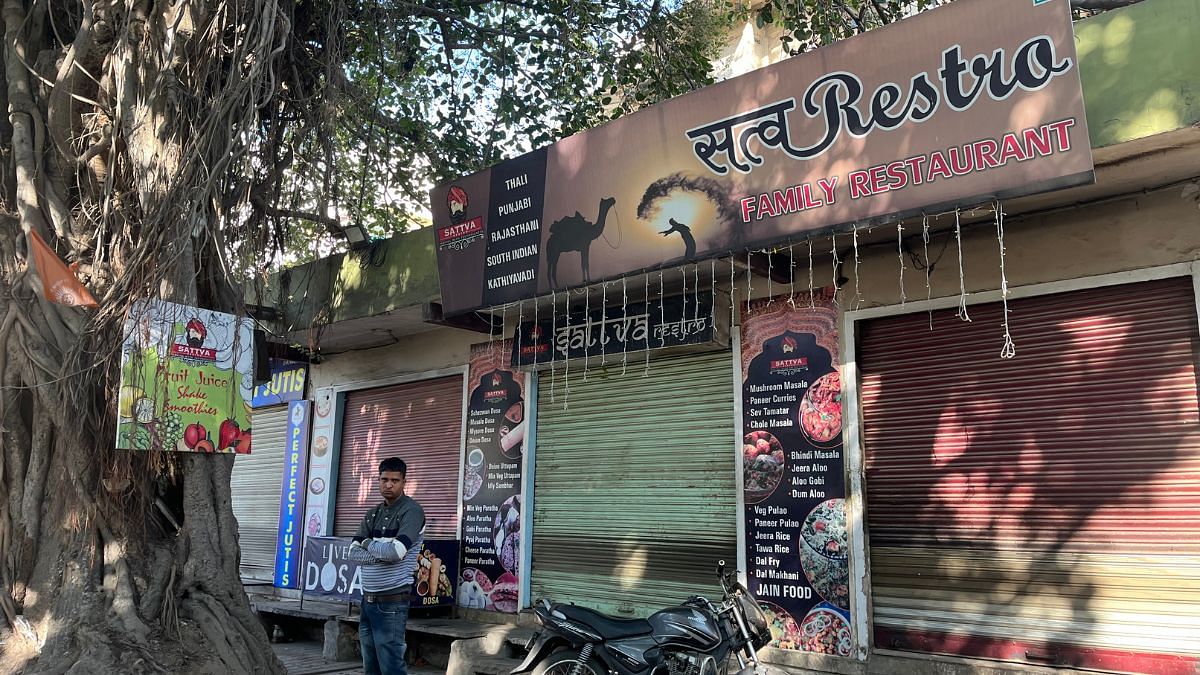
Also read: Who’s the real Nizam of Hyderabad now? A battle royale among contenders is brewing
History repeats itself
Forty years ago, right down to the month, Mahendra Singh, Vishvaraj’s father, was due to become Maharana. He was met with the same fate. He had filed the petition against his father the previous year, and was also banned from entering the palace in which he had grown up.
“The case had been filed the previous year (1983). But there’s never an easy time. I suppose it is kind of a strange full circle moment,” said Vishvaraj, referring to the turn of events. “It would’ve been nice if it had been done peacefully.”
The two Singh-Mewars are waiting in the sidelines for the court to finish its job. In 2020, a Rajasthan court ruled that the property would be divided three ways — between Mahendra Singh, Arvind Singh and their sister Yogeshwari Kumari. However, in 2022, the order was stayed by the Rajasthan High Court.
The Royal Family of Mewar routinely features in lists of India’s ‘Richest Royals,’ — with estimates listing their net worth at Rs 10,000 crore. However, in these lists, only Arvind Singh finds mention. Singh is at the helm of the HRH group of hotels, which owns 10 hotels. According to Lakshyaraj, there is only a “negligible amount” of property that’s under dispute. Vishvaraj said the opposite.
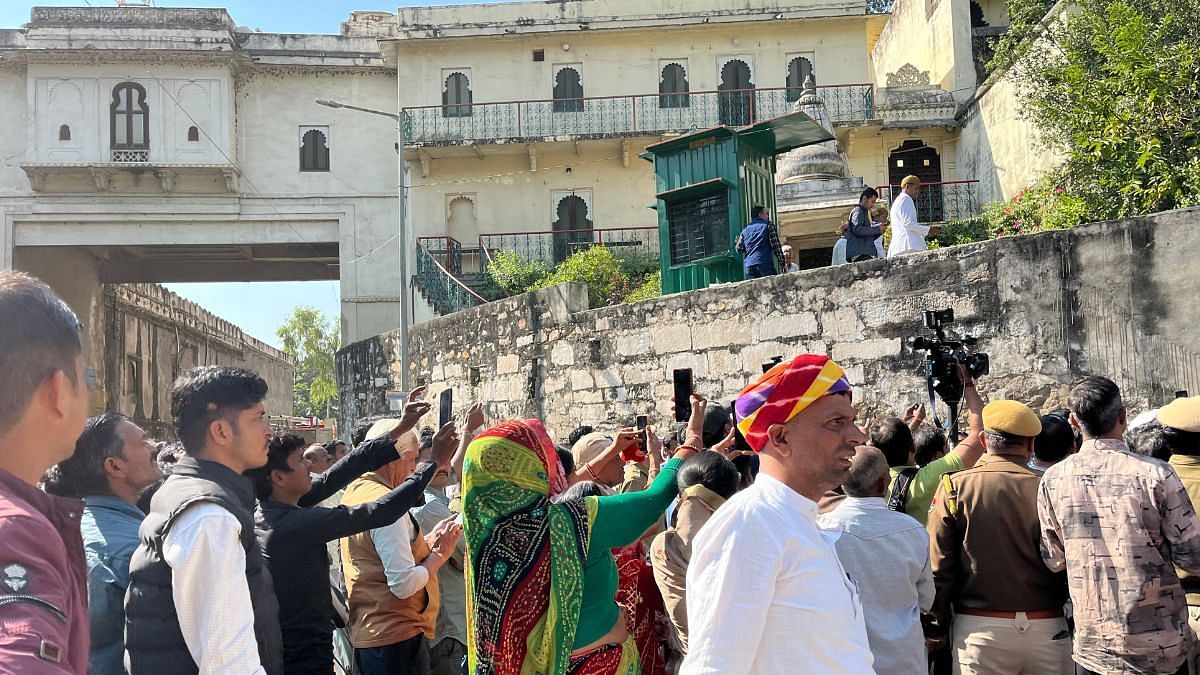
After Independence, among other things, the Mewar royal family was handed 20 palaces across, thousands of acres of land, and 900 kgs of silver.
55-year-old Vishvaraj Singh and 39-year-old Lakshyaraj Singh have never been on talking terms. When he was younger, Vishvaraj was friendly with his elder cousins, but Lakshyraj was too young.
The rift in the Mewar royal family became official in 1983, when Vishvaraj’s father, Mahendra Singh, filed a petition against Bhagwat Singh, Vishvaraj’s grandfather. Mahendra Singh was accusing his father of mismanaging their family estate by way of his laxity.
“His [Vishvaraj’s] own father filed a case against his father. He filed the title suit. Which ethical son does that? How can you do that?” said Lakshyaraj, standing outside the portion of the palace that is now the museum. “It’s arrogance.”
Since then, the family’s been embroiled in a long-standing property dispute over their various homes, hotels, and tracts of land peppered across Rajasthan. The separation of families over property and disputed wills is common to the point of mundane. But, according to those steeped in Rajput tradition, this is different.
“They’re custodians of the land. They’re supposed to serve it. We [Rajputs] do not live in our houses,” said Jai Arjun Singh Chundhwadh, another would-be umrao. “This is not some plot of land that’s just been bought. It’s about sacrifice and the people of Mewar.”
There is no direct flow of communication between the cousins. Instead, they talk through intermediaries: government, district administration, and family friends. When preparation for Vishvaraj’s coronation at Chittorgarh was underway, Randhir Singh Bhinder went to the palace — informing Lakshyaraj that Vishvaraj would need to enter the family shrine
On the other hand, for Lakshyaraj, the latest saga appears to be slightly less complicated. Trespassers entered his home, and that’s where the matter ends. The rest is for another day in court.
“I don’t just run a business. This is my home. You can’t enter with thousands of people,” said Lakshyaraj. “Does he not have a home? Is he on the streets?”
There is no direct flow of communication between the cousins. Instead, they talk through intermediaries: government, district administration, and family friends. When preparation for Vishvaraj’s coronation at Chittorgarh was underway, Randhir Singh Bhinder went to the palace — informing Lakshyaraj that Vishvaraj would need to enter the family shrine.
Some connections just can’t be severed. The two warring factions of Mewar live a stone’s throw away. They continue to have the same water supply — with the pump lying in Samor Bagh, Vishvaraj’s residence.
“The administration contacted us and said we should sit and talk. So I went to the City Palace [to meet with Lakshyaraj],” said Bhinder. “Whatever the court verdict is (in the property case), he should be gracious enough to help us.”
From a crack in the dense, overgrown foliage of Samor Bagh, the City Palace is visible in its glory.
“He [Vishvaraj] is not stopping them from taking water, but [Lakshyaraj] is stopping us from worshipping the deity,” Bhinder added, raising his voice.
When the palace gates were opened for Vishvaraj’s red SUV, it was because Lakshyaraj, along with the district administration, had granted him permission. Vishvaraj prayed to the deity, and Lakshyaraj was cocooned in another part of the palace — his home.
There isn’t much room for a personal settlement between his cousins. “This is as amicable as it’ll be. It is what it is,” said Lakshyaraj, shrugging his shoulders.
In Vishvaraj’s office in Samor Bagh, there’s a family photograph. Mahendra and Arvind Singh Mewar are surrounded by their staff and other nobility. There’s a dead leopard lying at their feet. It’s purportedly the result of Mahendra’s first hunt.
“Look, see how hazoor (Mahendra Singh) is sitting above Arvind Singh. Back then, that’s how it was,” said an elderly gentleman with an impressive mustache, part of Vishvaraj’s entourage of well-wishers.
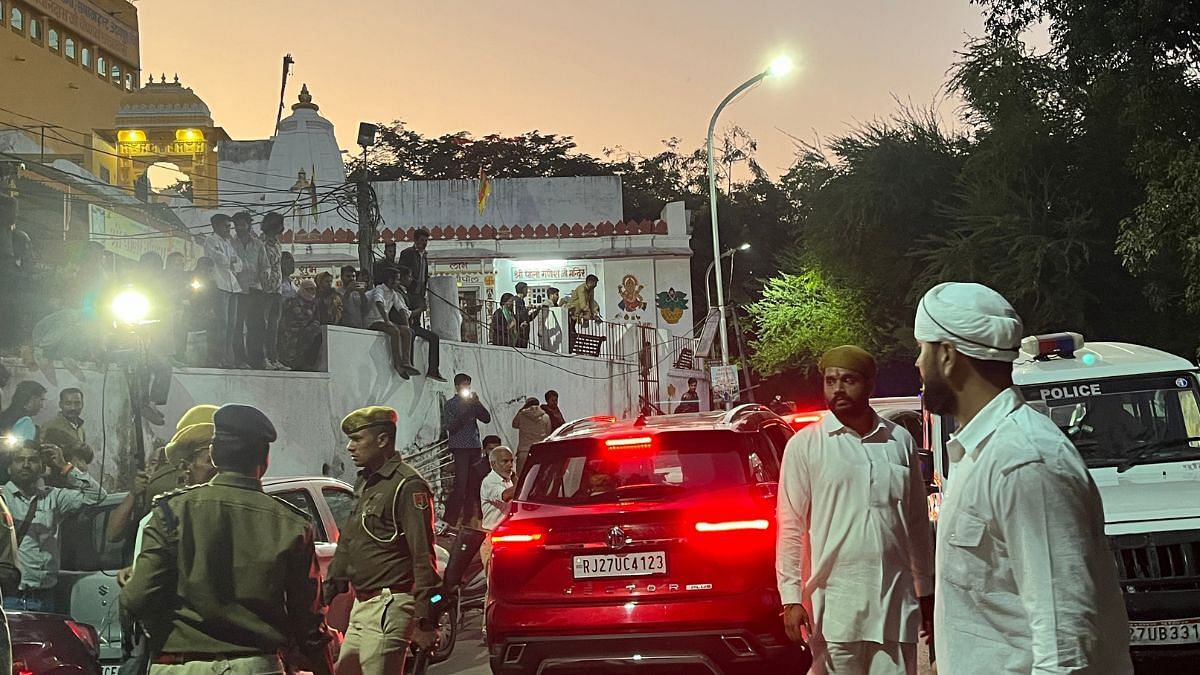
Also read: Babur, Akbar, and Abdali—the losses Panipat doesn’t want to battle anymore
Blood for Maharana’s tilak
Earlier in the day on Wednesday, Vishvaraj had completed his final ritual at Eklingji, a temple on the outskirts of Udaipur. According to Mewar lore, the Maharana is not a king — he is the dewan of Eklingji. As he walked through the town, his entourage expanded. People rushed out of their shops and homes. Some waved at him, and young Rajputs joined his procession. Some got out their dhols, others marched forward, determined to catch a glimpse, while others shouted slogans. Pride was palpable.
At Samor Bagh, people were encouraged not to come to Eklingji. Numbers were limited in order to prevent things from getting out of hand. Roads were cleared of traffic in order for his cavalcade to have free reign of the city.
It wasn’t just for Vishvaraj. People buzzed around Devvrat Singh Salumber, the current head of the erstwhile Salumber family. At Chittorgarh, as part of the coronation ritual, he sliced his thumb open with his sword, using his blood rather gracefully for the Maharana’s tilak. According to him, this is what’s in his DNA. He’s comfortable with shedding blood. But that’s because his family is “made for war.”
But this reverence isn’t restricted to the upper-reaches of Mewar society, clinging to a past that in certain contexts, is alive as the present. Hundreds and thousands of young men continue to experience Mewar and the Maharana as part of their lived reality.
“He’s living in the jungles just like Maharana Pratap,” said Hajala, tilak shining in the evening sun. “He’s not a slave despite all the injustices meted out to him. Maharana Pratap’s brother did the same thing.”
Standing a few feet away is Hemendra Samali, a journalist-turned YouTuber who now exclusively makes videos on Mewar culture and the erstwhile House of Mewar. His channel is packed with interviews of various family members, tourists attempting to experience Mewar, and the celebration of festivals.
Completing the trio is Vishal Singh, alias Chottu Banna. He shuffles his feet for a couple seconds, before declaring: “I know there’s no war happening. I know we live in a democracy. But I would die for the Maharana. For Mewar.”
(Edited by Anurag Chaubey)



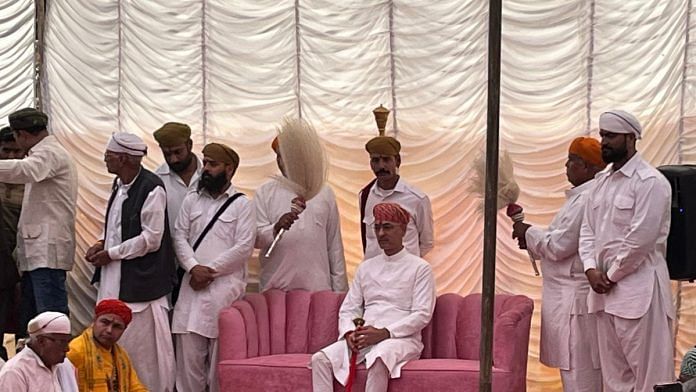



Lakshyaraj is a fraud. He fancies himself as the Maharana.
There is simply no comparison between the two cousins. Vishvaraj stands head and shoulders above Lakshyaraj. He actually comes off as a Maharana – a man of dignity, compassion and fortitude.
Both are certified a**holes.